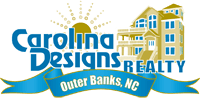Every area has its own phrasing to describe how to get around their community. First-time travelers to New York City likely won’t know references to the “Village” mean Greenwich Village. The same logic applies to San Francisco’s Nob Hill or Kensington in London. Those new to the Outer Banks will find local lingo is quite similar.
Navigating the Outer Banks is simple; everything is either north or south. The Atlantic Ocean is to the east and extensive bays, estuaries, and sounds are to the west. Even at its widest point, the Outer Banks is barely two miles across.
Nonetheless, when asking directions and a resident casually replies, “Oh, yeah, that’s in Colington,” your confusion will likely continue. We hope this north to south guide helps you understand the area more.
Corolla Village
Everything located north of the town of Duck and between the Dare and Currituck County line is considered Corolla . . . until you reach the four-wheel drive area.
However, Corolla Village is a small grouping of homes and businesses located around the base of the Currituck Beach Lighthouse. The structures lining the street are actually buildings from the original village, some of them dating back 125-150 years.
Carova
NC 12 ends about two miles north of Corolla Village. Although the paved road no longer exists, drivers with 4WD vehicles can proceed up the beach. The area north of the paved road is usually referred to by locals as Carova. However, properly speaking, Carova is the small village just south of the Carolina and Virginia border.
Duck Village
The Town of Duck has quite a number of subdivisions which are rarely referenced when providing directions. Yet visitors may hear locals refer to Duck Village, which is not a subdivision. When you hear this term, they are referencing the business district of Duck, an area that is roughly the same length as the Duck Boardwalk.
Kitty Hawk Village
Kitty Hawk is one of the oldest settled areas in Dare County. When the Wright Brothers came to the Outer Banks, they stayed with William Tate in what was then a village. The home is now gone, although there is a marker on Moor Shore Road indicating where the house once stood.
As a settled area, Kitty Hawk was never much more than a village, and that original area is typically referred to as Kitty Hawk Village or the Village. As a geographic reference, it is the area surrounding Kitty Hawk Bay from Moor Shore Road to Austin Cemetery.
Just past Austin Cemetery is a residential area called Kitty Hawk Landing. As a residential area, it’s something residents use in talking to one another, but just in case it comes up in conversation there is a reference for its location.
Kitty Hawk is where directions start to be given in mile markers, for example, “The Kitty Hawk Post Office is located at milepost 4 on the Bypass.” It’s also where people start referring to locations as between the highways or beachfront. The only two highways on the Outer Banks are US 158 (Carotoke Highway or the Bypass) and NC 12 (Virginia Dare Trail or the Beach Road). The towns of Kitty Hawk, Kill Devil Hills and Nags Head generally have two to three blocks of homes between the two roads. When you hear a local refer to a location between the highways, they mean roadways located between the Beach Road and the Bypass.
Colington
On the south side of the Wright Brothers Monument, a westbound turn onto Ocean Bay Boulevard leads back to the community of Colington. As an unincorporated part of Dare County, Colington is not actually a part of Kill Devil Hills, but since the only road to the island is through Kill Devil Hills, one would assume it is a part of the town.
Colington is its own community that consists of a smattering of stores and small restaurants. It’s also the home of Billy’s Seafood that was featured on Diners, Drive-ins, and Dives when Guy Fieri brought his show to the Outer Banks.
The island is one of the oldest settled areas on the Outer Banks. In 1663, the Lord’s Proprietors of the Carolinas granted this area to Sir John Colleton, a British noble. Although there is no record that Colleton visited his New World holdings, his name lives on in Colington Island. The established plantation was an abysmal failure that ceased operations by the 1670s.
First Flight Village
Located just to the north of the Wright Brothers Monument, First Flight Village is a community that is completely residential. Its boundaries are somewhat ill-defined, but West 1st Street is the heart of this community.
For those lucky enough to be on the Outer Banks during Halloween, the homes on West 1st going south to Canal Drive put on the most amazing Halloween display imaginable. This celebratory event is one worth experiencing at least once.
Whalebone Junction
As early as the 1830s Nags Head tourism had found a foothold in the town of Nags Head. There is a historic district along the Beach Road, although it is rarely used as a reference point. More likely, locals will refer to either Jockey’s Ridge, which is visually unmistakable, or Whalebone Junction.
Whalebone Junction is the intersection of US 158 (the Bypass) and US 64. It is either the beginning or the end for the routes, depending on how this point is viewed in your travels.
Village at Nags Head
Bordering Jockey’s Ridge to the south, the Village at Nags Head is a large subdivision that is often used as a reference point for directions, typically when providing directions to residential areas that are on the west side of the Bypass.
